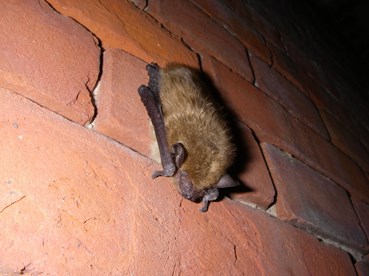DOVER (Aug. 19, 2016) – DNREC’s Division of Fish & Wildlife has been awarded a federal grant from the U.S. Fish and Wildlife Service (USFWS) to support Delaware’s ongoing research and monitoring and response to White-nose Syndrome (WNS), a disease that causes mortality in bats and has taken a severe toll on hibernating North American bat species since it was discovered almost 10 years ago.
Characterized by a white fungus visible on a bat’s nose, wings, tail and ears, WNS is transmitted primarily by contact between bats and since first discovered in New York in the winter of 2006-2007, has spread at an alarming rate and is now confirmed in 29 states and five Canadian provinces. According to the USFWS, while the disease is not known to impact human, pet or livestock health, WNS has caused the death of 5.7 to 6.7 million bats in North America. In Delaware, WNS related deaths were first confirmed in 2012 among bats hibernating in Fort Delaware and Fort DuPont in New Castle County.
The 2016 grant marks the seventh year that DNREC has received funding from the USFWS’s Endangered Species Recovery and Science Applications program to help fight the disease, with this year’s funding totaling $22,693.
“Bats are important to Delaware’s ecology, feeding on millions of insects, including mosquitoes, beetles, moths and agricultural pests, and in so doing, also helping us ward off potential threats to public health and the food supply,” said DNREC Secretary David Small. “Now we are trying to reciprocate with our concern over the bats’ health by working to help bats recover from WNS. Since 2009, DNREC has been monitoring the state’s bat populations and working with the public to limit the spread of WNS. Thanks to the U.S. Fish & Wildlife Service funding, we can continue strengthening our response to this disease that has been devastating to North American bats.”
Only bat species that hibernate are known to be affected by WNS, including such species as the little brown, big brown, tri-colored, northern long-eared and eastern small-footed bats – all found in Delaware. The northern long-eared and little brown bats are among the most severely impacted by WNS. Because of these bats’ dramatic population declines, the northern long-eared and little brown bats were added to Delaware’s list of endangered species in 2014, and the northern long-eared bat was listed as threatened under the federal Endangered Species Act in May 2015.

“The cave-like conditions at Fort Delaware provide ideal temperature and humidity levels for bats to hibernate and for the fungus that causes WNS to survive,” said DNREC Biologist Holly Niederriter, who heads the Division of Fish & Wildlife’s bat monitoring efforts. ”WNS continues to be a threat to bats that hibernate there. Our winter surveys at the Fort have shown a steady decline in bat numbers, with 40 percent fewer bats counted in 2015 compared to 2013.”
Hundreds of locations within Fort Delaware have been tested for the presence of the fungus that causes WNS, and potential methods for reducing the amount of fungus there have been evaluated. The microscopic spores of WNS can easily hitch a ride on shoes, clothing, cameras and backpacks, which led biologists to develop a plan in 2012 that prevents Fort Delaware visitors from inadvertently spreading the fungus from the Fort to unaffected areas. In addition, these grant funds were used to produce interpretive signs and an interactive kiosk to show Fort visitors the importance of bats and how to protect them.
“This USFWS grant provides much needed funds that will be used to collect data that will help us determine how to best protect Delaware’s bat species from WNS and implement strategies that will decrease the chances of spreading the disease to other bat sites,” Niederriter said. “We’ll also be using the funding to continue our efforts to educate visitors at Fort Delaware about bats and WNS.”
Delaware’s grant was part of almost $1 million in funding for natural resource agencies in 34 states and the District of Columbia that were announced by USFWS Northeast Regional Director Wendi Weber. “A state’s response to white-nose syndrome depends on how long the disease has been there or how close they are to known occurrences,” said Weber, who is also co-chair of the WNS Executive Committee. “Where it has been established, the focus is on increasing survival of bats. On the leading edge of the disease front, it’s also on limiting the spread, and where the disease has not been discovered, it’s on preventing the arrival of WNS. With this funding, we’re happy to help the states on all fronts to defeat this deadly disease.”
The Division of Fish and Wildlife is continuing its volunteer bat count project to search for bat colonies, monitor bats for signs of WNS and assess possible changes in bat populations. Delaware residents are encouraged to contact Holly Niederriter, DNREC Division of Fish and Wildlife at 302-735-8651 for more information.
For more information on bats in Delaware, please visit http://www.dnrec.delaware.gov/fw/bats. To report a bat colony or unusual bat behavior, please call 302-735-8651.
 ST. GEORGES (June 18, 2013) – A winning combination of citizen awareness, DNREC Division of Fish & Wildlife Enforcement, Tri-State Bird Rescue & Research, and the US Fish & Wildlife Service collaborated recently to rescue and subsequently return a pair of juvenile peregrine falcons to their nesting location on the St. Georges Bridge over the Chesapeake & Delaware Canal after the birds had “crash-landed” on the bridge’s roadway while attempting their first flight.
ST. GEORGES (June 18, 2013) – A winning combination of citizen awareness, DNREC Division of Fish & Wildlife Enforcement, Tri-State Bird Rescue & Research, and the US Fish & Wildlife Service collaborated recently to rescue and subsequently return a pair of juvenile peregrine falcons to their nesting location on the St. Georges Bridge over the Chesapeake & Delaware Canal after the birds had “crash-landed” on the bridge’s roadway while attempting their first flight.